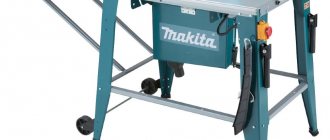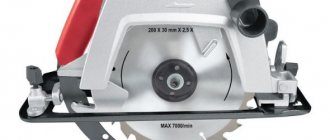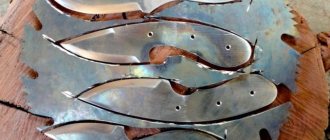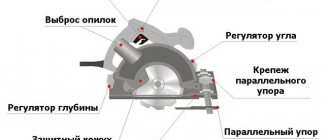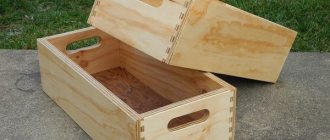Many novice craftsmen want to have a small but functional circular saw in their workshop. You can buy a factory-made machine, but it will be quite expensive. This is the path taken by professional carpenters, who have a direct material dependence of their financial condition on labor productivity. The invested funds quickly pay for themselves and bring direct profits.
DIY stationary circular saw
Amateurs have a good way out of this situation - to make a circular saw themselves using the tools that most craftsmen have. But before starting work, it is recommended to familiarize yourself with existing engineering solutions and operating features of the equipment.
Types of circulars
According to the method of performing the work, circular saws are divided into two types:
- Stationary;
- Hand tools.
Each type has its own characteristics, advantages, and disadvantages. The main difference between a stationary machine and a hand tool is the object of movement. On a stationary machine, the sawn material is moved along the saw blade; the hand tool is moved along the stationary workpieces.
A circular saw is chosen depending on the type and amount of work performed. To make a shelf for books, a stool, or a flower stand, all you need is a hand saw.
For mass production and sawing of long, dimensional workpieces, a stationary installation is used. Many experienced craftsmen have both types of circular saws at their disposal.
Miniature machine made from a washing machine engine
The circular is distinguished by its extreme simplicity and availability of materials for its manufacture. Perhaps its only expensive part is the electric motor. Stationary machines are equipped with a powerful asynchronous motor, which ensures cutting of thick wood of any species, but in a home workshop you can limit yourself to less power.
Note! To cut boards of medium thickness, it is enough to make your own circular table driven by a washing machine motor.
This design has a number of advantages. An engine from an old washing machine is inexpensive; moreover, a similar unit can probably be found in a home craftsman’s household. Connecting this motor is not particularly difficult; there is no need to look for circuit diagrams or do soldering. With all this, the power of such a unit is quite sufficient for most types of work.
The machine diagram can be simplified as much as possible by eliminating the belt drive. In this embodiment, the cutting tool will be mounted directly on the motor shaft. The base of the desktop mini-machine will be a frame assembled from a block with a cross-section of 40 x 40 mm. If desired, it can be welded from a corner or profile pipe.
Part of the body of an old TV, coated chipboard, is ideal as a stand (tabletop) for a circular table. As practice shows, this part is quite durable, and thanks to the varnish coating, it does not prevent the workpiece from sliding.
Using a jigsaw, two parallel cuts are made in the tabletop perpendicular to the cutout for the disk. A movable square will slide along them, playing the role of a side stop. It will help you make an even cut, if necessary, at a given angle.
Features of a manual circular saw
The tool is based on an electric motor with a saw blade mounted on a shaft. Models from different manufacturers have approximately the same design.
The products are equipped with many additional accessories:
- Start button with rotation speed controller;
- Protective casing;
- Retractable parallel stop;
- Regulators for cutting depth and tilt angle;
- Sawdust ejection pipe.
The saw blade rotates towards the base plate, towards itself. The main rule when working with a manual circular saw: first start the engine so that the disk begins to rotate, then carefully bring it closer to the surface to be treated.
The tool is convenient when performing the following work:
- Sawing boards, plywood, particle boards;
- Cutting timber, cutting slats;
- Recesses for groove tenons;
- Edge processing, chamfering;
- Cutting waste lumber for fuel.
The power of the device is selected based on needs. For short-term work in domestic conditions, processing workpieces up to 4.5 cm thick, a power of up to 1.2 kW is sufficient. Semi-professional tools have a power of 1.8 kW and cut workpieces up to 6.5 cm thick.
Professional equipment with a power of 2.2 kW can withstand long-term loads and leaves a cut of up to 8.5 cm. Woodworking enterprises use saws with a power of up to 5.5 kW; their weight reaches 100 kg.
Review and comparison of factory models
| Model | Einhell RT-TS 920 | Hitachi C10RD | Jet JBTS-10 | Metabo TKHS 315 |
| Power, W | 900 | 1600 | 1700 | 2000 |
| Cutting depth, mm | 45 | 73 | 76 | 85 |
| Diameter, mm | 205 | 250 | 254 | 315 |
| Spindle frequency, rpm | 4800 | 4800 | 5000 | 2990 |
| Weight, kg | 13,2 | 27,7 | 35 | 62 |
| Dimensions, mm | 580*455*340 | 730*590*370 | 1100*800*1020 | 860*620*470 |
Einhell RT-TS 920
Hitachi C10RD
Jet JBTS-10
Metabo TKHS 315
Requirements for the circular table
One of the advantages of a hand-held circular saw is that it can be mounted on a sturdy base, thus turning it into a stationary sawing machine. Such a device is especially convenient for sawing large lengths of source material into blanks of the same width.
Some brands initially offer a ready-made frame for the hand saw. It is convenient, but due to the small size of the work table, it is not suitable for working with large lumber.
Therefore, craftsmen make a table for stationary placement of hand tools on their own. The design and dimensions are chosen in accordance with your needs, capabilities, and available materials.
A homemade design must satisfy several requirements:
- Be strong, stable, withstand vibration and significant mechanical loads;
- The height is determined taking into account the height of the master, on average it is 65-75 cm;
- The dimensions of the tabletop are chosen taking into account the possibility of processing as many workpieces as possible; The width is considered close to optimal: 35-40 cm, length - 1.0-1.2 m; provide for the installation of additional blocks to increase the width and length of the table if it is necessary to saw long, wide slabs;
- The surface of the table should be smooth, even, without defects; in appropriate places, make a groove for the saw blade, holes for attaching a hand saw, a protective screen, and guide templates.
About safety precautions
Woodworking machines are equipment that creates increased danger. There is no place in a popular article to present the contents of volumes of technical specifications and technical specifications on them, and the home master is responsible for himself. Therefore, we will briefly show “from the opposite”: what a circular machine should not be like in order for work on it to be possible without injury or injury. An example of a “work” that violates all the essential rules for a more or less safe design of sawing and jointing machines is shown in Fig. (the electrical part is a separate topic).
An example of an incorrect and dangerous design of a circular sawing and jointing machine
Explanations for it:
- A – saw blade without protective cover. This is a common disease of almost all homemade circulars. Like, keep your fingers away from the saw, use the workpiece pusher, and everything is OK. So, for your information, now on the Internet you can easily come across a saw blade made using powder metallurgy methods. Having stumbled upon a carnation, it very readily shatters into small sharp fragments.
- B – the protrusion of the disk is clearly more than 1/3 of the diameter. “Snacks” of the workpiece twitching in the hands, shaggy stepwise cuts are inevitable. Injuries at work are more than likely.
- B – the power transmission is also not covered with a casing.
- G, D – table made of dissimilar low-quality materials. Transverse distortion of the workpiece and “bogging down” of the saw with all sorts of bad consequences are also quite likely.
DIY materials
The circular table consists of two main parts: a support (bed, frame), and a tabletop. The tabletop is a more important detail; the choice of material for it is taken especially carefully. Sheet material with great strength is suitable: thick plywood, particle board, textolite, aluminum sheet, steel.
Craftsmen make a table platform of the required size by connecting narrow wooden blanks together.
Suitable for the frame are wooden blocks, preferably made of hardwood material, aluminum, rolled steel: angle, channel, square and rectangular pipes. Steel products are more common and cheaper than aluminum.
- Wooden blocks for the frame are thicker: from 8x8 cm; connected to each other in various ways.
- Connection using grooves and tenons is the most labor-intensive, but it looks great and indicates a highly qualified craftsman.
- A simpler way is to connect using bolts and nuts. Metal corners are used to increase strength.
- Connection with nails is the most primitive, but fragile and short-lived.
The steel parts of the base are connected in two ways: bolts and nuts, or welding. A welded connection is used more often: it is easier and faster to make. At the beginning of welding work, it is important to control the values of right angles and the distance between parts, since during the welding process the metal heats up and deforms.
Step-by-step instruction
A durable, comfortable table for a manual circular saw will work if you stick to the action plan.
Its points are as follows:
- Determine the dimensions of the tabletop and supporting frame;
- Prepare drawings of parts indicating dimensions, material, quantity; you can use the examples, adjusting the shapes and sizes to suit your needs;
- Calculate the required amount of materials and fasteners; determine where scrap materials can be used and what needs to be purchased;
- The frame parts are connected sequentially, the top plate is prepared, and it is attached to the frame;
- At the bottom, through the prepared holes, a circular saw is attached, protection and guide stops are installed;
- The assembled apparatus is tested and modified if necessary.
